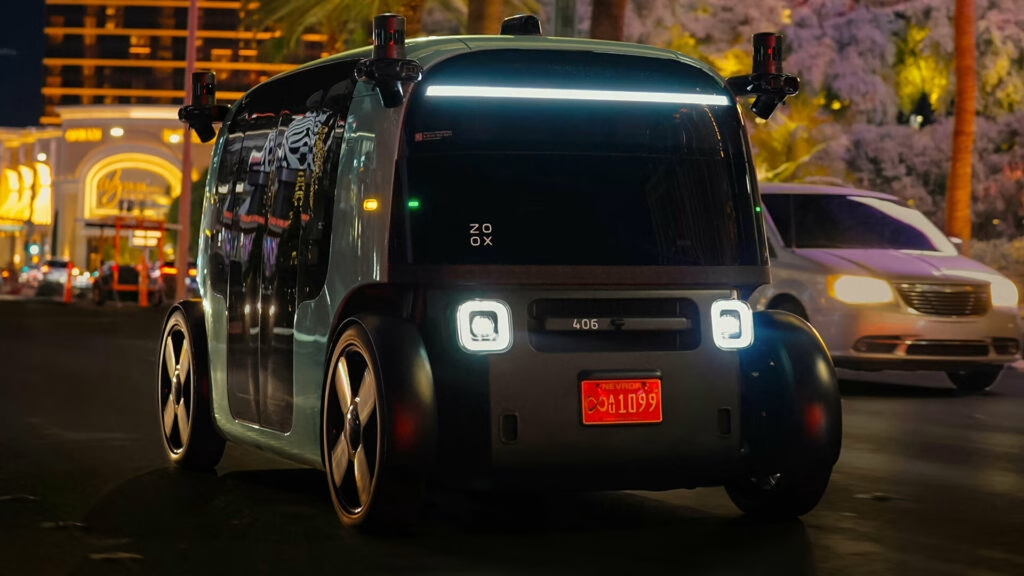How Does Zoox’s Robotaxi Service Actually Work in Las Vegas?
Picture this: you’re standing outside a glitzy Vegas resort, phone in hand, and instead of hailing a cab, you summon a driverless pod with the tap of an app. That’s now a reality thanks to Amazon’s Zoox, which just rolled out its autonomous robotaxi service on the Las Vegas Strip. The initial phase is all about getting people comfortable with the tech—rides are free for now, and you can book them directly through the Zoox app.
But don’t expect to go anywhere in the city just yet. The service is currently limited to a handful of popular destinations, including Resorts World Las Vegas, AREA15, Topgolf, and a few other entertainment hotspots. This focused approach helps Zoox manage safety, logistics, and the learning curve for both the vehicles and the public.
What’s the Experience Like for First-Time Riders?
Stepping into a Zoox robotaxi isn’t quite like hopping into a regular Uber or Lyft. For starters, there’s no steering wheel, no pedals, and—most notably—no human driver. Instead, you’re greeted by a futuristic pod designed from the ground up for autonomy. To make the transition less intimidating, Zoox has set up dedicated pickup and drop-off zones at major locations, complete with on-site concierges. These folks are there to walk you through the app, answer questions, and ensure your first ride goes off without a hitch.
The app itself is your command center. It shows you the license plate of your assigned vehicle, real-time arrival updates, and even a post-ride summary where you can leave feedback. This isn’t just a nice touch—it’s a crucial part of Zoox’s strategy to gather real-world insights and iron out any kinks before expanding further.
Is It Safe to Trust a Robotaxi With No Driver?
Let’s be honest: the idea of riding in a car with no driver still feels a bit sci-fi for most of us. Zoox knows this, which is why they’ve built in multiple layers of support. If something goes wrong during your ride, you can get help directly through the app or by pressing a dedicated help button inside the vehicle. And while autonomous driving technology has made huge strides, it’s not infallible—recent recalls and close calls in the industry have made headlines. Zoox’s cautious rollout, limited routes, and on-the-ground support are all about building trust one ride at a time.
According to the National Highway Traffic Safety Administration, autonomous vehicles have the potential to reduce traffic fatalities by up to 94% by eliminating human error, which is the leading cause of accidents. Still, every new deployment is closely watched by regulators and the public alike, especially after the US recently approved vehicles with no steering wheels or pedals for commercial use.
Why Did Zoox Choose Las Vegas for Its Debut?
Las Vegas isn’t just about bright lights and blackjack tables—it’s a city built for experimentation and spectacle. With its dense concentration of tourists, predictable traffic patterns, and a tech-friendly regulatory environment, Vegas is the perfect testbed for a next-gen mobility service. Zoox CEO Aicha Evans put it succinctly: Las Vegas is famous for unforgettable moments, making it an ideal launchpad for transforming the ride-hailing experience.
There’s also a practical angle. By focusing on a few high-traffic destinations, Zoox can gather meaningful data, manage operational risks, and refine its service before tackling more complex urban environments. It’s a smart move—think of it as a soft opening before the big show.
How Does Zoox Stack Up Against Other Autonomous Ride-Hailing Services?
Zoox claims to be the first to offer a fully autonomous ride-hailing service in a purpose-built robotaxi—meaning the vehicle was designed from scratch for autonomy, rather than retrofitting existing cars. This sets it apart from competitors like Waymo and Cruise, which have primarily used modified production vehicles.
The difference isn’t just cosmetic. Purpose-built robotaxis can optimize for passenger comfort, accessibility, and safety in ways that retrofitted cars can’t. For example, Zoox’s vehicles have bidirectional driving capabilities and symmetrical seating, so there’s no “front” or “back” in the traditional sense. The result? Pure magic for tech enthusiasts and a genuinely new experience for everyone else.
What’s Next for Zoox and Autonomous Mobility?
Right now, Zoox is keeping things small and manageable. Free rides are a clever way to drum up interest and collect feedback, but the company is clear: eventually, you’ll have to pay for the privilege of riding in a robotaxi. The real test will come when Zoox expands to more destinations, starts charging for rides, and faces the daily unpredictability of city life.
Industry analysts expect the global autonomous vehicle market to grow at a compound annual rate of over 22% through 2030, according to a recent report from Allied Market Research. As more players enter the space and public acceptance grows, services like Zoox could fundamentally reshape how we think about urban mobility.
The big takeaway? Embracing robotaxis isn’t about perfection—it’s about smarter adjustments. Start with one ride this week, and you’ll likely spot the difference by month’s end.

